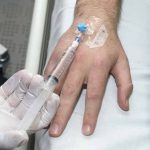 Although rheumatologists prescribe tumor necrosis factor inhibitors (TNFi’s) to treat several rheumatic diseases, they recognize immunogenicity influences the efficacy and safety of TNFi’s. Example: The formation of anti-drug antibodies can affect infusion reactions and cause low-serum drug levels and therapeutic failure. The induction phase is a period of high incidence of immunogenicity, and observational data suggest low drug levels in the induction phase are associated with low remission rates. Consequently, some clinicians use therapeutic drug monitoring during induction to improve remission rates.
Although rheumatologists prescribe tumor necrosis factor inhibitors (TNFi’s) to treat several rheumatic diseases, they recognize immunogenicity influences the efficacy and safety of TNFi’s. Example: The formation of anti-drug antibodies can affect infusion reactions and cause low-serum drug levels and therapeutic failure. The induction phase is a period of high incidence of immunogenicity, and observational data suggest low drug levels in the induction phase are associated with low remission rates. Consequently, some clinicians use therapeutic drug monitoring during induction to improve remission rates.
Therapeutic drug monitoring should make it possible to optimize drug levels and provide early identification of anti-drug antibodies, improving the efficacy, safety and cost effectiveness of TNFi therapy. Some clinical guidelines even recommend the use of proactive therapeutic drug monitoring. However, therapeutic drug monitoring can be costly and time consuming.
Studies estimate that 50–90% of gastroenterologists in Europe and the U.S. use therapeutic drug monitoring to regularly assess serum levels for TNFi’s. Although less frequently used by rheumatologists, therapeutic drug monitoring is one potential strategy to help patients with rheumatic disease taking TNFi’s achieve remission. But will it work?
Effect on Remission Rates
New research demonstrates that proactive therapeutic drug monitoring does not improve clinical remission rates in patients with immune-mediated inflammatory diseases initiating treatment with the TNFi infliximab. Silje Watterdal Syversen, MD, PhD, a consultant rheumatologist and researcher at Diakonhjemmet Hospital, Oslo, Norway, and colleagues conclude their findings do not support routine use of therapeutic drug monitoring during infliximab induction. They published their results from a randomized controlled trial studying the effectiveness of therapeutic drug monitoring in a range of immune-mediated inflammatory diseases on May 4 in JAMA.1
The Norwegian Drug Monitoring trial part A (NOR-DRUM A) included 411 adult participants with an inflammatory disease—rheumatoid arthritis (RA; n=84), psoriatic arthritis (PsA; n=45), spondyloarthrtitis (SpA; n=119), ulcerative colitis (n=83), Crohn’s disease (n=58) and psoriasis (n=22)—who were initiating infliximab therapy. The investigators chose the large, diverse group of patients to reflect real-life practices. They randomized patients (1:1) in the open-label trial to receive either proactive therapeutic drug monitoring, with dose and interval adjustments based on scheduled monitoring of serum drug levels and anti-drug antibodies, or standard infliximab therapy without drug and antibody level monitoring. Patients received at least two doses of the study drug, with a recorded treatment decision for the third dose. The median serum level of infliximab was 6.9 mg/L in both groups.
Overall, the study had a high retention rate and tight adherence to the treatment algorithm. Definitions of clinical remission in each diagnosis were based on well-established measures of disease activity with predefined cutoff points. These included a Disease Activity Score in 28 Joints lower than 2.6 in patients with RA and PsA, Ankylosing Spondylitis Disease Activity Score lower than 1.3 in patients with SpA and Psoriasis Area and Severity Index of 4 or lower in patients with psoriasis.
Results: The proportion of patients who experienced disease remission after 30 weeks was 50.5% in the therapeutic drug monitoring group and 53% in the standardized therapy group—a difference that was not statistically significant. At week 14, 49.1% of patients in the therapeutic drug monitoring group and 54.7% of patients in the standard therapy group attained clinical remission—again, not statistically significant difference. The median time to remission was 56 days in the therapeutic drug monitoring group and 46 days in the standard therapy group. The researchers found no significant differences between the groups in time to remission or time to sustained remission.
The investigators documented adverse reactions in 68% of patients in the therapeutic drug monitoring group and 70% of patients in the standard therapy group (not statistically different). Infliximab was discontinued in 30% of patients in the therapeutic drug monitoring group and 22% of patients in the standard therapy group (not statistically different). The most frequent adverse events were related to infections, including upper respiratory tract infection, influenza-like illness and lower urinary tract infection.
The investigators concluded that therapeutic drug monitoring was not superior to standard treatment for achieving disease remission. However, they note the trial did not have statistical power to test hypotheses within each disease subgroup.
Old School Medicine Works
Dr. Syversen expressed surprise that therapeutic drug monitoring did not improve efficacy. “We believe that negative data are also important for clinical practice,” Dr. Syversen says, noting that the findings stand in contrast to the fact that proactive therapeutic drug monitoring has been adopted in multiple different specialties.
“We feel that our results put to rest a long-standing debate on the merit of therapeutic drug monitoring in all patients starting TNFi,” she says. Dr. Syversen suggests that, because the previous studies were observational, they may have been affected by confounding and selection bias.
“It’s reassuring that what we do works,” says Brett Smith, DO, a rheumatologist at Blount Memorial Physicians Group, Alcoa, Tenn. “It reinforces that we have the best clinical practice at this time. We can usually tell when we lose response. … After the disease shifts, we know it’s over at that point.” Dr. Smith is also impressed by the fact that the study reported consistent findings across six diseases.
“Our clinical skills are the most important things that we have,” says Dr. Smith, noting the study emphasized the importance of “old school medicine.”
Important Caveats
Dr. Syversen acknowledges that a more targeted application of therapeutic drug monitoring, such as assessment of serum drug levels in treatment failures, may still be a useful clinical tool. This approach would include applying therapeutic drug monitoring and following up closely in patients with risk factors for immunogenicity and those for whom emerging treatment failure is suspected.
Also, Dr. Syversen explains high doses of TNFi’s are used during induction and that these high doses may have hampered the effectiveness of therapeutic drug monitoring during the induction phase of therapy. She hypothesizes that therapeutic drug monitoring may be more effective during maintenance therapy and will explore that question in the NOR-DRUM B trial.
Of note, a subset of patients in the NOR-DRUM A study—those developing anti-drug antibodies—did benefit from therapeutic drug monitoring. The authors write that this subset (18% in the therapeutic drug monitoring group and 17% in the standard therapy group) may have been too small to influence the results on a group level, but the role of therapeutic drug monitoring for these patients should be evaluated more closely.
Additionally, 10% of patients in the therapeutic drug monitoring group and 15% of patients in the standard therapy group had anti-drug antibodies above the threshold for discontinuation defined in the treatment algorithm. Because infliximab is the most immunogenic TNFi, with the highest interindividual variation in serum concentrations, Dr. Syversen does not believe therapeutic drug monitoring would be more effective during the induction of other TNFi’s.
The researchers documented a significantly lower rate of infusion reactions in the therapeutic drug monitoring group than in the control group, suggesting a role of proactive therapeutic drug monitoring in preventing infusion reactions, and they intend to explore this in future studies.
Lara C. Pullen, PhD, is a medical writer based in the Chicago area.
Reference
- Syversen SW, Goll GL, Jorgensen KK, et al. Effect of therapeutic drug monitoring vs standard therapy during infliximab induction on disease remission in patients with chronic immune-mediated inflammatory diseases. JAMA. 2021. 325(17):1744–1754.


